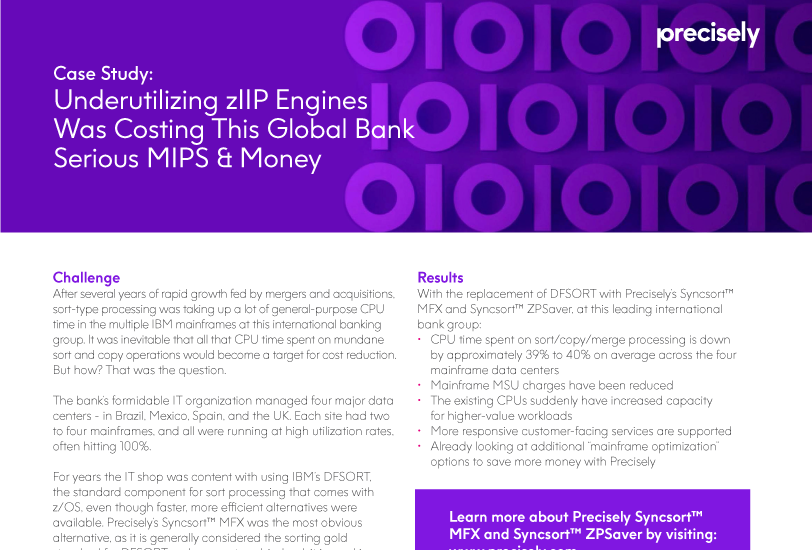
IBM Mainframe Solutions
IBM mainframe sort optimization solutions
Get the most out of your mainframe by improving efficiency with cutting-edge sort, copy and join operations, while offloading workloads to IBM zIIP engines to slash CPU costs

Mainframe performance and cost challenges
IT departments in larger enterprises are challenged to keep pace with rising data volumes from distributed applications that depend on mainframe transaction processing power. The pressure to squeeze more performance out of existing mainframes, while avoiding or deferring major upgrades, is non-stop.
Routine sort processing tasks such as sort, copy, merge, compression and report generation take up a large and disproportionate share of CPU processing time and related mainframe resources. They are thus obvious areas to examine when seeking relief from mainframe cost and performance pressures.
Syncsort™ MFX has a rich history of exploiting the advanced facilities of the z/OS and IBM z platform to optimize performance and it provides significant cost benefits for thousands of mainframe organizations. Precisely’s deep IBM Z expertise has yielded superior and well-documented sort performance, along with comprehensive resource management and data manipulation features.
Improving sort efficiency
Sorting data is one of the most MIPS-intensive functions a mainframe performs, consuming as much as 25% of CPU cycles. So when businesses need to improve mainframe performance while maintaining or decreasing costs, optimizing sort performance is a frequent area of focus.
Sorting also operates behind the scenes of other processes, such as data compression, increasing the impact of sort performance on system efficiency. As a result, reducing the resources used for sorting can significantly increase overall system efficiency. Syncsort™ is a high-performance sort, copy and join application designed to take advantage of the latest IBM Z architecture to improve sort performance over IBM’s DFSORT solution.
Syncsort™ PipeSort is a key component of the Syncsort™ MFX Suite, offering the fastest method for sorting the same file many times with different key sequences. Syncsort™ PipeSort can simultaneously execute up to eight differently-sequenced sorts in a single pass, without having to enter data multiple times. Using cutting-edge parallel sorting technology, Syncsort™ PipeSort can cut total elapsed time by more than 50% compared to separate sorts, while also significantly reducing the I/O overhead.
As a licensable feature of Syncsort™ MFX, Syncsort™ PipeSort is the perfect utility for meeting the constraints of batch windows with especially large files and multiple sort key sequences. It can be a powerful solution to help save time, computing resources, and mainframe cost.


Saving money with IBM zIIP processors
IBM z Integrated Information Processors (zIIP) are purpose-built processors designed to operate asynchronously from general processors (CP) in the mainframe. They provide additional computing capacity, without any associated software licensing charges, because IBM does not impose software license charges on zIIP capacity. Since additional license charges may apply when general purpose CP capacity is used, zIIPs can be purchased and used without increasing MSU charges, enabling IT organizations to control costs.
Sort, copy, and related compression activities dealing with high volumes of data result in significant CP resources being consumed. Offloading CP resources to zIIPs for those operations provides organizations with additional capacity and helps to ensure that the total MSU expenditure is kept under control.
Syncsort™ ZPSaver, a licensable feature of Syncsort™ MFX, can offload up to 90% of all sort, copy, and SMS compression CPU cycles to the IBM z Integrated Information Processor. This helps IT to make better use of resources by exploiting zIIP engines, while saving money and improving the speed of mainframe operations. Syncsort™ ZPSaver executes transparently using existing Syncsort™ MFX JCL and control statements – significantly reducing general processor utilization. Additional reductions are also obtained in elapsed time when compared to non-zIIP enabled sort operations.
Securing mainframe data with encryption
In a world of constant security threats, data breaches, and expanded compliance regulations, data security capabilities have come to the forefront for all organizations. Driven by government and industry regulations and mandates such as FIPS, HIPAA, and GDPR, businesses are challenging their IT departments to protect their data and digital assets with a rigor never seen before. Data encryption minimizes the impact of a data breach or unexpected data exposure by ensuring that data is unreadable by unauthorized users or malicious actors.
The IBM mainframe platform and z/OS operating system provide a variety of cryptographic capabilities to help organizations encrypt and protect critical data assets in motion or at rest.
Enhanced data protection for many z/OS data sets, zFS file systems, databases, and Coupling Facility structures gives users the ability to encrypt data without costly application changes to embed encryption APIs. z/OS encryption policies make it possible to use encryption to protect critical datasets and files while ensuring compliance with regulations.
Technologies such as Precisely’s Syncsort™ MFX have expanded support for encryption beyond the sort input and output datasets to incorporate encryption for temporary SORTWK datasets.
This additional level of encryption ensures data remains protected during critical processing phases on the z/OS platform as well as when at rest and in motion. The zIIP-offload capability of Syncsort™ ZPSaver also provides zIIP-enabled encryption for sort input, sort output, and SORTWK datasets, ensuring maximum performance on the IBM z/OS platform, while protecting the integrity of critical data assets, and ensuring compliance mandates are met.


Understanding your unique sort environment
Sorting is an important task that occurs frequently on the mainframe and uses large quantities of system resources. The efficiency of your sort environment can have a serious impact on overall system throughput.
Precisely can help you understand your individual sort performance and tuning opportunities. Highly experienced Precisely analysts can review and analyze information about your organization’s mainframe environment, sort load, and configuration. Our experts will design a customized set of best practices that take into consideration your unique environment, workload, and tuning objectives. Additionally, you will gain an understanding of how these recommendations were made. This will allow you to adjust your best practices in the future when there is a change to your environment.
Precisely’s Performance and Tuning Service is designed to educate organizations on the factors that affect sort and system performance in general, and to review and tune existing applications to meet the performance criteria of the organization. Clients will also gain an understanding of how to keep their configuration tuned so sorts will continue to perform optimally as their environment evolves.

Financial Services Firm Saves Millions via Sort Offload
Many organizations that have purchased zIIP processors are not gaining full benefit by making full use of those processors. In essence, they purchased an engine, but can’t get it out of first gear.
With transaction volumes and workloads soaring, Syncsort™ MFX helped this company save millions via Sort Offload to zIIP.
Case study: Telecommunication Delays CPU Upgrade with Syncsort™ ZPSaver
With CPU utilization peaking at 100% in the daily batch window when critical billing jobs were running, this telecommunications firm was seeing the performance of the jobs being impacted, along with an occasional inability to complete all jobs within the window. They were looking at an impending upgrade which they could neither afford nor manage.
Read our 50 Years of Mainframe Sorting Innovation white paper and learn about some of the innovations in Syncsort™ MFX over the past 50 years.
50 years of innovation
Predicting the future of mainframes can be tricky, especially since the tech world is always looking for the next “big thing.” Even with pundits questioning the longevity of the mainframe, it is still very much alive and growing as a system for running mission-critical, transaction-intensive workloads. Although the role of mainframes has certainly changed somewhat over time, they remain essential in many major industries. It seems a safe bet, then, that mainframes will continue to thrive.
Even as the marketplace explores new hybrid applications, cloud deployments and open source solutions, you can be confident that the mainframe will continue to play a critical role in your enterprise. Evaluating ways to improve the efficiency of core workloads, like sorting, can help you uncover additional capacity, and it can potentially save money and increase the ROI for mainframe expenditures.
The mainframe has survived the ebb and flow of technology innovations over the past 50 years, and it’s likely to remain a centerpiece of IT shops for the next 50.



